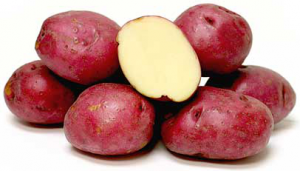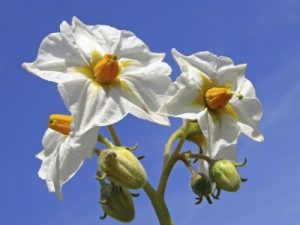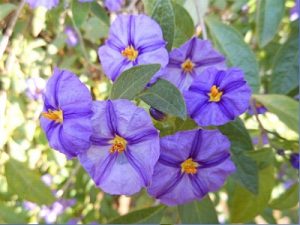It originated in the highlands of Peru, particularly the region around Lake Titicaca. Over 200 species of wild potato are found in the Americas, and they all developed from the red rose potato.
Dr. Sebi On The Red Rose Potato
Transcribed by Zee Malachi
I didn’t say the sweet potatoes was alright, that was made too. The red potato. The red rose, that was found in lake Titicaca in Peru. That is where the Irish people became acquainted and took it back to Ireland. Remember, the Irish people were the first to go to Peru. They did a lot of research in Peru. And they did a lot of things in Peru. And when they found this potato they took it back to Ireland and they begin to hybridize the potato and get what you call the russet potato, the red rose, but the natural potato look like the red rose. The red rose; I would recommend that you eat that because it’s the first generation away from the mother. From the base, which came from Lake Titicaca. But Not a sweet potato. A sweet potato has such a high concentration of nitrogen that it would really play havoc on the system.
 Solanum Tuberosum (Red Potato)
Solanum Tuberosum (Red Potato)
Names: Also known as “New Potatoes” when harvested early.
Appearance: small to medium; round or slightly oblong; smooth, thin red skin; white flesh
Texture: waxy, moist and smooth; creamy
Flavor: subtly sweet; mild medium sugar content
Preferred uses: steaming, boiling, mashing, salads, soups/stews
Potato Variety 1
Potato Variety 2
Potato facts
Dr. Sebi has been able to recommend specific beans (garbanzo “aka” chic peas), rice (wild rice) and potatoes (red rose) as the least detrimental foods for us to consume while we return to the African Bio Mineral Balance (an approach that compliments the African gene structure). Depending on the state of our health, some of us don’t eat any of these at all as a contribution towards the effort to heal as quickly as possible.
The more people that become familiar with the food recommendations of Dr. Sebi, the more people start trying to acquire them and grow them. That being said, I’m sure you would like to know that the red rose potato is not as resistant to disease as modern-day potatoes. The genetic clone of the modern-day potato when bred, will inherit strengths and weaknesses of its parents. Diseases and macrobiotic strains are passed down to the point where there is nearly no chance in a million for them to grow without receiving a lot of sprays and fungicides. So we will definitely have a sharp eye on our suppliers for red rose potatoes where ever they are. We want to know what they are using to help the red potato grow.
That depends on what it may take to turn us off and away from consuming the red rose potato. Green potatoes (red rose or not) are poisonous and should never be eaten. The green is a result of being exposed to light. Then we learn what happen soon after the red potato left Peru. It is reported that the German botanist Edward Pöppig (1798–1868) searched and discovered the “original” wild potato after traveling to Chile and Peru in 1827. By the time the Irish got their hands on the potato and continued to breed, they were hit with a potato famine in 1844.
 Nearly one-eight of the Irish population suffered by 1851 as one million of them were dead from starvation or disease. By 1855 two million people fled from Ireland.
Nearly one-eight of the Irish population suffered by 1851 as one million of them were dead from starvation or disease. By 1855 two million people fled from Ireland.
Kind of makes you wonder, what in the heck did they do to that red rose potato? The answer is “NO!” – we are not ready to eat the Red Potato. What we have today is a version far from the one Dr. Sebi was recommending. But for those of you who will eat it anyway, below is some very important information for you.
Two things we look for. One we learn from Dr. Sebi (The starch content) and the other we learn from our chefs (toxic prevention). Lets start with what we learn from our chefs.
TOXIC PREVENTION
When we prepare any potato we should boil or steam only until we we reach a golden or light-brown color; NO DARKER! Cooking potatoes to a deep brown creates a compound called acrylamide, a “probable human carcinogen,” which in animal studies have been shown to cause cancer (in high levels). It’s the starch inside that reacts to the heat. Baking, grilling, and roasting can cause acrylamide to form, but frying produces the most. So french fries and potato chips are among the most toxic. Rinsing potatoes in water before any kind of cooking helps reduce acrylamide formation. Acrylamide can also be found in bread, cereal, coffee (because the beans are roasted), and other foods.
I guess it’s time to address frying foods now right? Acrylamide, turns up in foods (mostly starched-based ones) when they are fried, baked or otherwise cooked at high temperatures. It forms from sugars and an amino acid naturally found in food, as part of the Maillard Reaction (that’s the chemical reaction that transforms the flavor and color of food when cooked). So if you are going to fry foods, make sure that they are the least detrimental and as less the starch content as possible.
THE STARCH CONTENT
So lets jump right into the starch concerns. The red rose potato definitely has less starch than the russet potato. Red potato is considered a waxy potato because of its thin skin. A starchy potato is dry and mealy when baked. The flesh plumps up and breaks apart, sucking up any moisture that comes along. A starchy potato drinks in the juice of a luscious roast beef, or the butter and sour cream that is added. The red potato holds its shape after cooking and is not as absorbent.
As with most produce, look for potatoes with the skin intact and without bruising. They should be firm, not mushy. The papery skin on red and new potatoes might be flaky, and that’s okay.
HOW CAN I TELL HOW STARCHY IT IS?
Don’t know if your potato is starchy or waxy? Cut it in half. If there is a white, milky film on the knife and the halves stick to the knife, the potato contains a lot of starch. Lower starch potatoes don’t produce much white liquid, plus the halves slip off the knife easily.
THE POTATO FLOWER
Potato plants produce flowers during the end of their growing season. These turn into the true fruit of the plant, which resemble small green tomatoes. Potato plant flowering is a normal occurrence, but the flowers usually just dry up and fall off rather than producing fruit.
Potato plants are herbaceous perennials that grow about 60 cm (24 in) high, depending on variety, with the leaves dying back after flowering, fruiting and tuber formation. They bear white, pink, red, blue, or purple flowers with yellow stamens.












This is amazing knowledge.
Did dr. Sebi ever say anything about eating guavas? Thanks.
Not that I can find.
Yes is a no natural plant is a starch base plant
I like potato chips, do you have any sugestions?
I like potato chips too. Stop eating them. Keep thinking that you don’t want to eat them and one day you will stop eating them.
Thank you for sharing this with us.
I am very thankful of this website and Dr. Sebi but I am wondering if you’ve skipped over my question about guavas, if you could advise me about guavas being man-made or a God natural fruit that would be very nice of you Mr. Zee.
he responded on May 11th, He couldn’t find anything Sebi said about Guava. One key I look for if it’s something I have a question about is can it be found growing wild somewhere?
Your right, I would love to obtain most veggies and fruit wildcrafted because its been growing by nature.
They grow wild here in saint kitts too. The ones I know are sour though.
Does the original potato still exist in Peru?
No it does not. The one we can find around here (USA) are definitely hybrid.
Guava had been growing wild in Kenya especially in western Kenya. My grandfather who lived before Europeans entered told me that they used to eat wild guava when they were young and looking after cattle
Thats great information! Would there be a way for me to obtain the gauva seeds from kenya? Maybe purchase them online? I love guavas! My father grew up in Jamaica eating them, they’re the best fruit!
Hi Mr. Zee,
Thank you for your answer! I wanted to find a source to buy the organic red rose potatoes, would you know a safe and honest organic store to buy real organic red rose potatoes to grow in my garden? Could I find any online in an international store?
Thanks!
Eye innerstand the red rose potatoes. So as long as the red potatoes skin is thin in tact & also not waxy, sticky or milky the red potatoes is good.
Only thing is produce delta will be mad seeing me cut their potatoes in halves checking the textures.
The Red potato is not good to eat. But if you’re going to eat it anyway, this is the information you need to know.
https://www.melissas.com/Organic-Red-Potatoes-p/231.htm
Are these the correct potatoes?
The article from the advocates is written in a way that you should not want to go out and consume these potatoes. -WARNING- they are not safe.
I also like potato chips. I’ve replaced my potato chip consumption with plantain chips. I even make them myself. I lightly fry them with grapeseed oil. Plantains are on Dr. Sebi’s nutritional list.
Plantains are not on Dr. Sebi’s nutritional list. Green bananas use to be listed under vegetables but it has been removed. The only bananas that are promoted on the list is: the smallest one or the Burro/mid-size (original banana).
Platains are boru figs(bananas) I’m from Trinidad so obtaining these bananas are easy. But I recalled Dr sebi stating to stay away from the green plantains and only consume the over riped ones (black&yellow)
He mention a short blocked banana referred to as the chapa.
You can make kale chips which I find to taste better than potato chips.
What about purple potatoes? Any information on those?
Red potato, purple potato, none of these are good!!!!!
So, is there no potato left in the world that is healthy to eat? I stumbled across a wild Andean potato that I am curious about. Also, to be clear, are you stating that the “fruit” that grows on a potato plant after it flowers is what should be eaten? Thank you for your answers and informative article.
No potato is safe to eat. Excuse my ignorance as it is merely how I feel. If you are able to determine that there is a potato worth eating, then you have done yourself a good service. Enjoy it and good health to you. In regards to the fruit that grows on the potato, I was more pointing out seed baring substances than substances that can be eaten. Not everything with seeds should be ate. However, it’s still worth looking into.
I want to know all of the non hybrid food to improve my health ? I also want to know what is the cost for a couple to go to the healing village of Dr Sebi in the Honduras ?
I thank God for Dr Sebi and everyone working his program.
Be sure to study this website for some of that information.
Is their still a way to get my hands on some seeds for the Red Rose Potato? I would love to add it to my garden. I saw a website selling red rose potato.
Well, our article here doesn’t really recommend that people eat this.
And I quote … “ The red rose; I would recommend that you eat that because it’s the first generation away from the mother “. How is a recommendation not a recommendation? Sorry, just seriously wondering.
[QUOTE FROM WEBSTE] …..”What we have today is a version far from the one Dr. Sebi was recommending. But for those of you who will eat it anyway, below is some very important information for you.”
So in conclusion, those who trust the recommendation will eat it. I don’t, but for those who do, I go as far as presenting how to prepare the potato for a least detrimental experience.